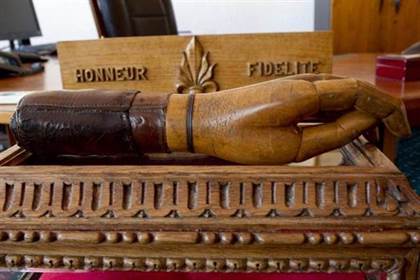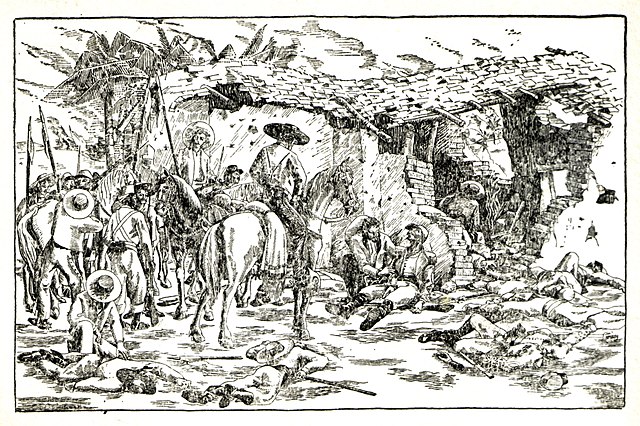It is April 30, 2023, 160 years after the battle of Camerone.
We are going to present you a “narrative”, that is to say, a form of communication telling a series of events, real and/or imaginary, in chronological order, in order to better understand what took place between the Mexican army and the French army. The facts that have been transmitted to us orally, for the most part, by the different protagonists, are not the reflection of a historian’s work but, they evoke a story intended to transmit values, those of the Foreign Legion.
What is it about?
Napoleon III, taking advantage of the Civil War, intervened in Mexico. This useless and disastrous expedition to Mexico, dictated in large part by Empress Eugenie, came to nothing (see). And yet, the battle of Camerone, a minor event in history in the context of the Mexican expedition, allows us to understand how the Foreign Legion made it the keystone of its tradition.
Since its independence in 1821, Mexico had weakened considerably, especially in the economic sphere. In 1861, the country could no longer repay its European creditors: Spain, France and the United Kingdom. Napoleon III saw a good opportunity to extend his informal empire and his “soft power” over the New World while strengthening the ties between France and Austria by offering the Mexican crown to Archduke Maximilian, brother of the Austrian emperor. Nothing goes as planned…
The international operation against Mexico
On December 17, 1861, the Spanish, based in Cuba, landed in Mexico, followed by the British Navy and then the French. The sanitary situation was not good, yellow fever was rampant in this region called “Hot Lands”. The signing of a new financial agreement allowed the Spanish and the British to withdraw their troops while the French Empire entered alone in a phase of the conquest of Mexico under the command of General Latrille de Lorencez.
The siege of Puebla
With less than 7,000 men Lorencez marched on the city of Puebla de Los Angeles, which he believed to be devoted to the monarchists and ready to open its doors to him. Unfortunately, the fortified city was defended by 12,000 Mexicans. Without any popular support, Lorencez nevertheless tried an assault that turned out badly before retreating to Oriziba where he waited for the reinforcements coming from France. 23,000 men disembarked under the command of General Elie-Frédéric Forey. Before marching on Mexico City, Forey decided to organize the siege of Puebla where he arrived on March 12, 1863. The road between Veracruz and Puebla, about 100 km long, was essential because it was the only one that allowed the French expeditionary corps to be supplied. On April 29, 1863, a large convoy set out in the direction of Puebla and it was the third company that was sent to meet the convoy in order to protect it. It was composed of 65 infantrymen commanded by Captain Jean Danjou, Second Lieutenant Jean Vilain, and Second Lieutenant Clément Maudet, no officer being available, all of them suffering from yellow fever (vomito negro).

The battle of Camerón (Camerone)
Warned of their passage, a Mexican force of 1,200 infantrymen and 800 cavalrymen went to meet the 65 French infantrymen. When the battle began, Captain Danjou victoriously repelled several cavalry charges and entrenched himself in the hacienda of Cameron de Tejeda in order to keep the enemy at bay as long as possible.
Faced with the overwhelming majority of men (2,000 vs. 65), the Mexican army summoned Captain Danjou to surrender. He answered “We have cartridges and we will not surrender” and then he swore to defend himself to the death and made his men take the same oath.
At 10 a.m., Danjou and Lieutenant Vilain were killed and at 2 p.m. there were only 12 men left in fighting condition, under the authority of Sub-Lieutenant Maudet.
When the final assault was made, Maudet was hit to death and only three legionnaires were left alive, including Corporal Louis Maine. A Mexican officer saved them by asking them to surrender, which they did on the condition that they could relieve their wounded and keep their weapons. “We don’t refuse anything to men like you!” the officer replied.
The oath of all these men was kept and the balance sheet, after 11 hours of fighting, shows 300 dead and 300 wounded on the Mexican side, the loss of two-thirds of the 65 men, the others, wounded were treated.
Their sacrifice was not in vain since the French convoy reached Puebla safely.
Napoleon III decided that the name of Cameron would be inscribed on the flag of the Foreign Regiment and that the names of Jean Danjou, Jean Vilain, and Clément Maudet Maudet would be engraved in gold letters on the walls of the Invalides in Paris.


As for Louis Maine, a street is named after him in Mussidan..

The founding myth of the Foreign Legion
The Foreign Legion was created in 1831 by Louis-Philippe for use in Algeria. It distinguished itself in Algeria, then in Crimea (1854-1855), Italy (1859), and Mexico (1863-1867).
A monument was erected in 1892 on the site of the battle. Abandoned, it was rebuilt for the centenary of the battle in 1963 with the inscription
“There were less than sixty of them here
Opposed to an entire army.
Its mass crushed them.
Life rather than courage
Abandoned these French soldiers
In Cameron on April 30, 1863 “
At Cameron, the soldiers fought a hopeless and distant battle, but their exemplary behavior fixed the legionary “spirit”: they accomplished their mission, whatever it took!
The sacred aspect of the event is completed by the presence of a “relic”, the wooden prosthesis of Captain Danjou’s hand. Regardless of how it was found, it is regularly displayed during the great celebrations.

Even if the heroic battle of Camerone represented only a small event on the scale of the conflict, its story may have served for a time to mask the final failure of the Mexican expedition. Nevertheless, it was the “founding myth”, the outstanding event in which the elders were given as an example. The “spirit of Camerone” still permeates the legionnaires who have the ability to obey and fight to the death. Abnegation and sacred sense of duty.
Conclusion
We are in the presence of an excellent story that allows us to highlight the exceptional qualities of our soldiers.
References
On the internet the bibliography is abundant.
We can refer in particular to the following papers:
Histoire de la légion étrangère
Bataille de Camerone Wikipédia
Bataille de Camerone (30 avril 1863) (Histoire pour tous)
Featured image: late 19th-century postcard showing Mexican soldiers relieving wounded legionnaires after the Cameron battle on April 30, 1863.
(189)
Autor: Prof. François Renaud



